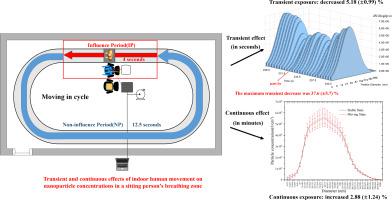Science of the Total Environment ( IF 9.8 ) Pub Date : 2021-08-28 , DOI: 10.1016/j.scitotenv.2021.149970 Jialin Wu 1 , Wenguo Weng 1 , Liangchang Shen 1 , Ming Fu 2

|
Particle concentration in a sitting person's breathing zone can be influenced by human movement around the person, and the transient and continuous effects may differ. In this study, a set of full-scale experiments was conducted to sample the nanoparticle concentration in the breathing zone of a sitting thermal breathing manikin (STBM). The transient fluctuation of the nanoparticle concentration was recorded continuously and analyzed. The results showed that when a manikin moved (at 1 m/s) past the STBM, the nanoparticle concentration in the STBM's breathing zone decreased and reached its lowest after the standing manikin had passed, decreasing 37.6 (±5.7) % compared with the peak value. The average concentration in the STBM's breathing zone during influence periods was 5.18 (±0.99) % less than that during non-influence Periods (NP). This finding reflected the fact that the transient inhalation (over several seconds) of the STBM may be reduced by manikin movement. On the other hand, the exposure of the STBM increased 2.88 (±1.24) % when there was a continuously moving manikin compared with the stable state in a 10-min observation. This finding may be explained by the fuller mix of indoor air and nanoparticles caused by manikin movement, as well as the increase of nanoparticle suspension time. The difference in the transient and continuous effects of the manikin movement on the STBM's exposure shows the importance of considering these effects separately in different scenarios.
中文翻译:

室内人体运动对坐着的人呼吸区纳米颗粒浓度的瞬时和连续影响
坐着的人呼吸区中的粒子浓度会受到人周围人的运动的影响,并且瞬态和持续影响可能不同。在这项研究中,进行了一组全尺寸实验,以对坐着的热呼吸人体模型 (STBM) 的呼吸区中的纳米颗粒浓度进行采样。纳米颗粒浓度的瞬时波动被连续记录和分析。结果表明,当人体模型移动(以 1 m/s)通过 STBM 时,STBM 呼吸区中的纳米颗粒浓度下降,并在站立人体模型通过后达到最低,与峰值相比下降了 37.6(±5.7)%价值。影响期间 STBM 呼吸区的平均浓度比非影响期间 (NP) 低 5.18 (±0.99) %。这一发现反映了一个事实,即假人运动可能会减少 STBM 的瞬时吸入(超过几秒钟)。另一方面,与 10 分钟观察中的稳定状态相比,当存在连续移动的人体模型时,STBM 的暴露增加了 2.88 (±1.24) %。这一发现可能是由于人体模型运动引起的室内空气和纳米粒子的更充分混合,以及纳米粒子悬浮时间的增加。人体模型运动对 STBM 暴露的瞬时和连续影响的差异表明在不同场景中分别考虑这些影响的重要性。24) 在 10 分钟观察中,与稳定状态相比,连续移动人体模型时的百分比。这一发现可能是由于人体模型运动引起的室内空气和纳米粒子的更充分混合,以及纳米粒子悬浮时间的增加。人体模型运动对 STBM 暴露的瞬时和连续影响的差异表明在不同场景中分别考虑这些影响的重要性。24) 在 10 分钟观察中,与稳定状态相比,连续移动人体模型时的百分比。这一发现可能是由于人体模型运动引起的室内空气和纳米粒子的更充分混合,以及纳米粒子悬浮时间的增加。人体模型运动对 STBM 暴露的瞬时和连续影响的差异表明在不同场景中分别考虑这些影响的重要性。



























 京公网安备 11010802027423号
京公网安备 11010802027423号